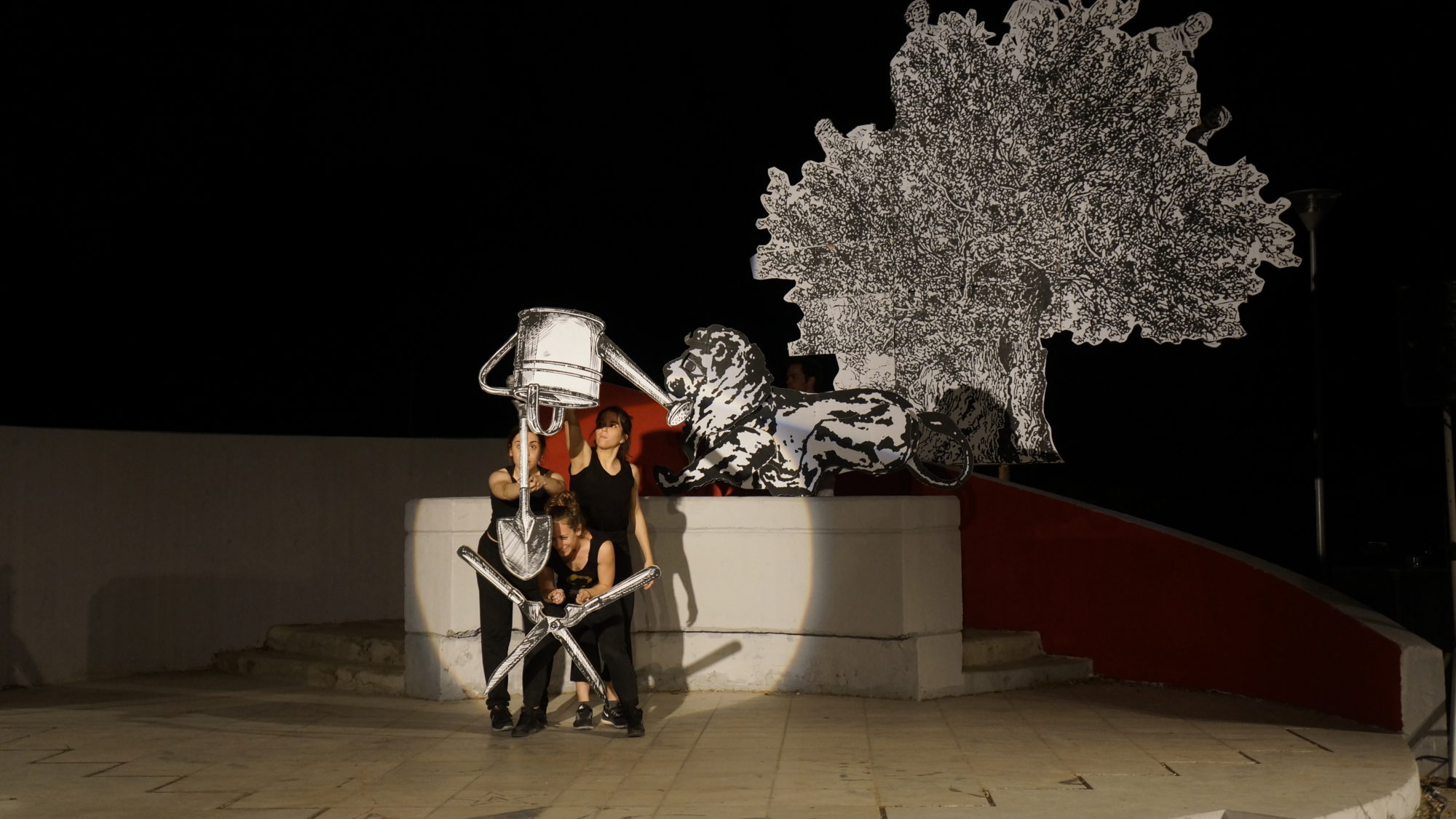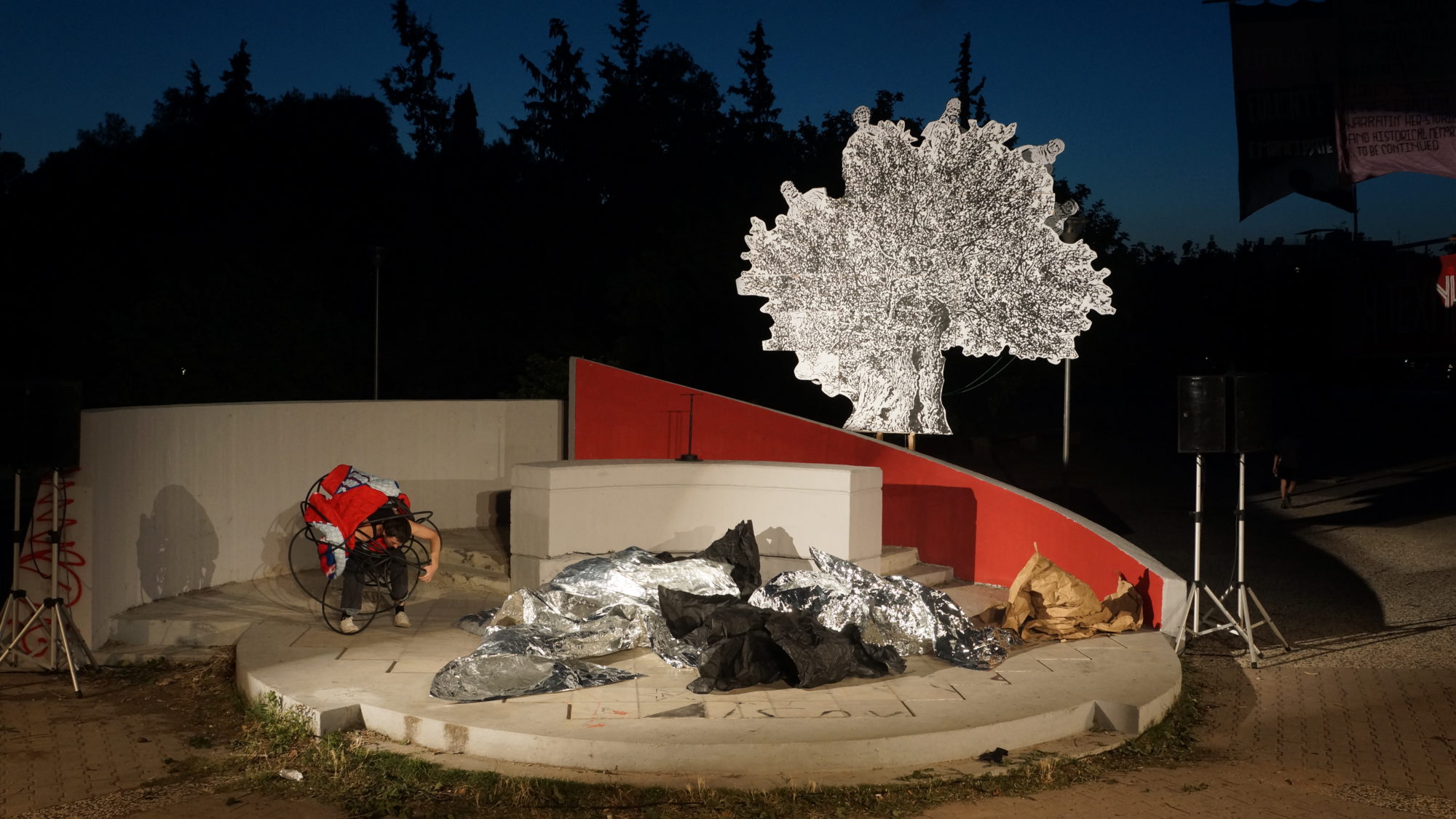Deep Focus
On Fables

Learning Play Park Fables by Chto Delat. Commissioned and produced by: Onassis Cultural Center/ Fast Forward Festival 5. Curator: Katia Arfara. Courtesy of the author.
“[T]he critique which goes beyond the spectacle must know how to wait.” —Guy Debord1
This short sentence sounds like a proper moral conclusion, like what we might remember from different classic fables.
For a long time, our collective, Chto Delat, was concerned with different forms of narration that could reflect the conditions of the world and society and could show them as a constructed material reality in the process of transformation.
We were inspired by the tradition of estranged storytelling, which we have been deriving from Brecht and other masters of this genre, thinking about how it can be developed now. And we have started to think about the old fable tradition. We often like to actualize some forgotten or outdated phenomena and test them, to see if they have some potential to be implemented into the new reality of our contemporary world.
Why fables? The historical fable is a fictional story realized, “in prose or verse, that features animals, legendary creatures, plants, inanimate objects, or forces of nature that are anthropomorphized (given human qualities, such as the ability to speak human language) and that illustrates or leads to a particular moral lesson (a ‘moral’).”2 We think this traditional medium of storytelling can be reclaimed as a powerful device of estrangement, one capable of touching on many issues of current politics.
It is important to remember that the fable is a medium for the distribution of a certain type of knowledge that enlightened people (like priests, politicians, school masters, the elite in general) communicate to the ignorant, thus educating them. Fables presume that there is a normative understanding of a reasonable type of organization—of the society, of the universe, and of governing—and that there are certain deviations that should be revealed, criticized, and corrected in real life. The fable ridicules and flaunts these bad qualities of human behavior and their typical manifestations. This is possible due to the fact that there is an idea of the norm.

Learning Play Park Fables by Chto Delat. Commissioned and produced by: Onassis Cultural Center/ Fast Forward Festival 5. Curator: Katia Arfara. Courtesy of the author.
At first glance, the continuation of this enlightened and didactical approach may be troublesome. On the one hand, it belongs to the past, to the homogeneous societies that could develop shared common values; in today’s society, it is definitely not the case. On the other hand, with more careful observation, we can analyze a rise of different forms of aggressive moralization coming from diverse social groups that are trying to establish their own points of view. We face a clash of truth-telling, relevant not only to so-called progressive social groups (like antiracists, feminists, ecologists, and so on) but also to new conservative groups that are challenging the established norm of political correctness, which recently became destabilized.
Some people are sure that this or that monument, picture, or story with a historical burden is not appropriate for public presentation and should be destroyed. Other people are sure that this or that articulation offends their beliefs and should be excluded from public discourse. Different groups feel themselves right to make a categorically moral judgment and do not hesitate to implement a material conclusion, in the form of destruction, fights, endless trials, and so on. This means that the fable’s time is coming back.
Practicing the genre of the fable today means, first of all, to carefully analyze how different voices in society are constructed. This genre has a power to address society in a challenging way: activating the process of self-questioning and the common search for the truth as a dialogue of different competing voices.
Another important aspect of the fable’s construction is its banality. In a world where everyone is forced to be original, the implementation of banality has a shocking effect. A fable is banal; it engages a very simple structure, which challenges one to respond in a more complex way and to build some conclusion. A fable’s banality provokes us to think of common sense. This approach could help to recreate a common space outside of the ghettos of cultural differences, identities, and subcultures.

Learning Play Park Fables by Chto Delat. Commissioned and produced by: Onassis Cultural Center/ Fast Forward Festival 5. Curator: Katia Arfara. Courtesy of the author.
A fable might be something that demands certain consequences; truth-telling demands a response. Contemporary people most likely are afraid of taking responsibility. Fables could challenge the status quo, of intellectual production based on the making of opinions and the market value of their circulation.
In conclusion, we return to Guy Debord’s 1967 text, whose conclusion began our essay.
If the logic of false consciousness cannot know itself truly, the search for critical truth about the spectacle must simultaneously be a true critique. It must struggle in practice among the irreconcilable enemies of the spectacle and admit that it is absent where they are absent. The abstract desire for immediate effectiveness accepts the laws of the ruling thought, the exclusive point of view of the present, when it throws itself into reformist compromises or trashy pseudo-revolutionary common actions. Thus madness reappears in the very posture which pretends to fight it. Conversely, the critique which goes beyond the spectacle must know how to wait.3
One could read this as a readymade fable. We need only decide how to share the roles and what kinds of animals could represent false consciousness, truth, effectiveness, and madness. And maybe we can derive a different moral conclusion than what was offered to us.
1. Guy-Ernest Debord, thesis 220 of “Ideology Materialized,” chapter 9, The Society of the Spectacle.
2. “Fable,” Wikipedia.
3. Debord.
